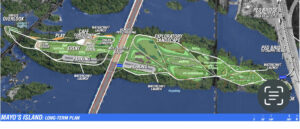 by Jon Baliles
by Jon Baliles
Some great news this week about the one thing most everyone can agree on: the James River is awesome, and the heart of the City just got a LOT more awesome. Or at least it is pointing in that direction. Mike Platania at Richmond BizSense reported that The Capital Region Land Conservancy (CRLC) is under contract to buy Mayo Island with the ultimate goal to create public green space. The “CRLC has made an initial security deposit on the island and is currently in the due diligence phase” and expects to close on the property next year.
“If successful … Mayo [Island], that has been long-discussed and long-envisioned for a public space, can now become that in the future,” CRLC Director Parker Agelasto said. “…Mayo is truly going to be the green space that everybody has been yearning for, with a nice walkability from the Hull Street corridor.”
Agelasto added that the CRLC is waiting to hear back from the Virginia Land Conservation Foundation about a grant it applied for that would help fund the purchase. The grant money would come from the state’s Community Flood Preparedness Fund.
“It’s not a guarantee,” Agelasto said. “[But] we feel very good about where we are at the moment.”
Amen to that. As the CRLC noted in its press release, this goal has long been in people’s dreams but never really close to reality — until now. “Forty years ago the City of Richmond’s 1983 Master Plan noted ‘the conversion of Mayo Island into public open space is recommended due to its accessibility by City residents, including the handicapped, the availability of excellent fishing opportunities, and the potential for boating access’.”
Twenty-five years ago, in July 1996 the report “An Evaluation of Mayo Is Island for Potential Public Access for Recreation and Open Space Use” was issued. The acquisition of Mayo Island has been detailed in subsequent plans such as the Richmond Downtown Plan (adopted in 2009), Richmond Riverfront Plan (adopted in 2012), and James River Park Master Plan (adopted in 2019).
Agelasto told Colleen Curran at the Richmond Times-Dispatch that removing eight acres of asphalt will be one of the most vital tasks after the completion of the sale:
There is a heron rookery nearby and it’s where the sturgeon, shad and herring come to spawn. It has become an important place for natural wildlife in the heart of our city. It can also offer recreational opportunities when open to the public. It’s something that a lot of people have envisioned. Look at Belle Isle as an example of how walking trails can get people down to the river. Mayo Island is a very different part of the river, where people could fish, put in a paddleboard or canoe or kayak.
This is such great news it’s hard to quantify — but very easy to get excited because of the possibilities and what it will do to burnish and elevate even further Richmond’s reputation as a world-class outdoor city. If you recall the Mayo Island renderings in the Riverfront Plan from a decade ago, you start to see the possibilities and should be confident and eager to get going because with the CRLC leading the way and engaging with the City and the community, Mayo Island and its environs will be unlike any other park or space in America.
It’s a big, winning trophy with a blue ribbon standing tall, above all else, right in the middle of the James River, surrounded by water, rapids, trails, history, green space, people, and wildlife. And it’s freaking awesome.
***
The RTD has some great aerial photos of the island over the years that are definitely worth a look.
This report was first published by Jon Baliles on RVA 5×5. It is republished here with permission.

Leave a Reply
You must be logged in to post a comment.